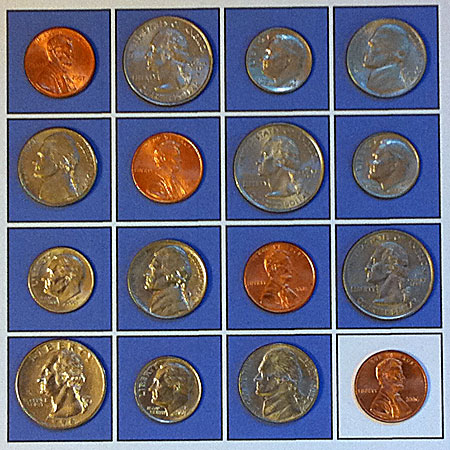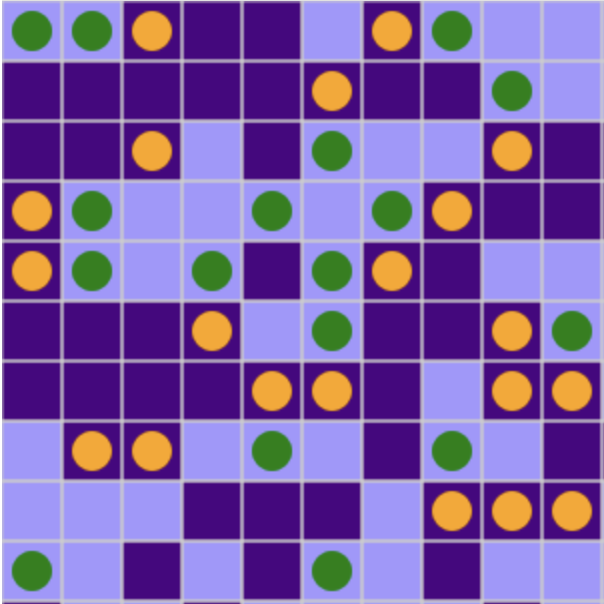The Bits Come Out to Play Again
by Brian Hayes
Published 6 August 2025
Some months ago a reader of bit-player.org emailed to ask me: “Have you given any thought to ensuring that the website remains after you have shuffled off this mortal coil?”
It’s a fair question. After all, I’m an antique—a relic from the midpoint of the previous century. However, I still keep a firm grip on my mortal coil. Or maybe it has a grip on me. In either case, I have no plans for shuffling off anytime soon.
Of more immediate concern is the health and wellbeing of the bit-player website. Lately it has suffered from neglect and loneliness; it’s the Tamagotchi I have failed to nurture. I’ve posted nothing new here since September of 2023, two years ago. Since then, bit rot has taken its toll. Certain dark corners of the site have accumulated cobwebs of comment spam, which I’ve been too distracted to sweep out. And the software running on the the web server has grown crotchety and brittle, subject to occasional bouts of cardiac arrhythmia. Also, the site is inhospitable to all you squinty folks who want read on the tiny screen of a telephone. (The pages were designed when telephones had dials, not screens.)

A snapshot of the first bit-player posting, in its original livery, published 9 January 2006. Note the rounded corners at the top of the page, which were oh-so-trendy in those days. Note also that I wasn’t able to get through even a single paragraph without a typo. (Thanks to the Internet Archive for preserving this document.)
I am writing this post to announce that bit-player is coming back from the not-quite-dead. All the old content is here, and the appearance is mostly the same, but the infrastructure supporting the site is new. In essence, I have jacked up the whole building and set it down on a new foundation. The site should now be easier to maintain. It might even survive for a little while after I have uncoiled. The articles should be more accessible on phone screens and other devices with a touch-and-smear interface. I also hope to make it easier to find what you’re looking for (or to find something you didn’t know you were looking for). But there’s more work to be done in that department.
The impetus for these changes was to preserve and provide ongoing access to an archive of existing work—things I’ve written over the past 20 years or so. But digging into the website’s innards has renewed an itch to write and publish new essays here. I don’t know how much of that will actually happen, but I hope you’ll stay tuned.
Webbery
If you would like to know more about the technology behind the new site, I recommend the document About bit-player. Here I’ll just say a few words about my goals in the renovation: I wanted to make everything simple, self-contained, and safe.
The former version of bit-player was a “dynamic” website, where pages were assembled on demand, like made-to-order pizzas. Fragments of text, images, menus and buttons, bits of code, stylesheets—all the components of a page were brought together on the fly by software called WordPress. The WordPress system, along with its supporting database and its many plugins and attachments, is an impressive creation, but simple it is not.
The new bit-player is a “static” site, meaning the pages are prefabricated, with all the parts assembled at the time of writing and publication. This preparatory work happens on my personal computer. All the server has to do is serve: When you request a URL, it delivers the appropriate file. This process is simple enough that the server can probably be kept running with very little maintenance (although somebody has to pay the bills).
The new site is self-contained in the sense that it doesn’t require live access to any external resources. Earlier versions of bit-player have relied on fonts provided by Google, and on software libraries (notably the MathJax program for rendering mathematical notation) hosted by the Cloudflare content-distribution network. Now everything that appears on a bit-player page comes directly from the bit-player.org server. Why should anyone care where the files come from? Well, I have no control over what Google and Cloudflare might do in the future. They might stop offering the services I’ve been relying on, in which case my website would break down. Worse, they might be acquired by a hostile agency who would substitute malware for requested files. There’s also a privacy issue. When you visit a website that draws resources from third parties, those parties are able to track your movements across the web. These days, it’s almost impossible to avoid that kind of surveillance, but I don’t want to abet it.
Converting to a static site brings one lamentable loss: bit-player can no longer accept and publish comments from readers. This is a major sacrifice; looking back over the archives, I find that the comments are often more interesting than what I wrote in the original text. I have preserved the comments attached to earlier stories, but for now there’s no way to submit new comments. I don’t know how to implement such a facility within the architecture of the website. There are third-party solutions, such as Disqus, but again such services compromise privacy (even for those who never post a comment).
Managing comments is also a challenge for me, and for any caretaker who might manage the site when I’m gone. The internet is a public space, and a comment-submission form is a portal to publication open to anybody (or anybot) that can pass a CAPTCHA challenge. I should not have been surprised when the comment section began to fill up with sales pitches and stock tips and mysterious nonsense aimed at influencing search engines. Under WordPress I employed a third-party filtering service called Akismet. It reported blocking 640,478 spam comments. Hundreds more slipped through the filter every year and had to be removed by hand.
Is there a better way to foster two-way communication on a website? If you have any ideas, I’m eager to hear them. You can reach me the old-fashioned way: brian@bit-player.org
Future Directions
The banner at the top of this page promises “An amateur’s outlook on computation and mathematics.” Those subjects remain close to my heart and uppermost in my mind, and I expect to continue writing about them for as long as I have two fingers to poke at the keyboard. But I have other interests as well, and I’m now inclined to broaden the reach of bit-player. Some genres I may visit in the coming months:
- Fiction. You might well ask what I’ve been doing these past two years, when I haven’t been posting on bit-player. The answer is I’ve been at work on a novel and a few pieces of shorter fiction. Novels are not a novelty for me; I’ve been writing fiction all my life, but I have published almost none of it. I may try posting a few bits and pieces here.
- Reviews. I’m a reader as well as a writer, and there are books I have something to say about.
- Revivals. Most of the “Computing Science” columns I wrote for American Scientist were once available in HTML form on the magazine’s website, but many have since fallen by the wayside. I’d like to try republishing a few of them here.
- The Real World. I tend to see art and science and mathematics as a refuge from the worries and troubles of life, both private and public. Having a math problem to puzzle over is a great comfort, a way of preserving one’s sanity when the world outside your window is going apeshit. But there comes a time when you mustn’t look away from the scene of horror, and you mustn’t stay silent about what you see. My speaking out will not stop the carnage, but I need to speak all the same.
A Blog for the Ages?
What is the life expectancy of a website? Longer than you might think, given the evanescence of other computer technologies and data formats. The World Wide Web burst into public view 30 years ago, in the mid-1990s. Yet lots of web pages from that era are still functional. For example, I first put a “Computing Science” column on the web in September of 1995; when loaded into a modern browser, that document still looks much the same as it did in Netscape Navigator. The look, of course, is rather primitive. CSS, the language for adding styles to HTML text, would not be introduced until the next year.
The custodians of the three principal web languages—HTML, CSS, and JavaScript—have been diligent protectors of backward compatibility. New features are added, but older methods still work. I applaud this policy of moving slowly and taking care not to break things, and yet it can’t last forever. Will a 2050 version of Firefox or Chrome be able to parse and display the pages I’m writing in 2025? Will web browsers even exist in 2050, or will the whole idea of the WWW be shoved aside as new schemes for organizing and distributing knowledge take hold? I’m happy to do what I can to keep the bit-player website on the air, but I see it as a temporary measure at best.
In the long run, it’s really none of my business whether my writings survive for the benefit of posterity. They will endure if and only if future generations find them interesting or useful (or laughable) enough to be worth the effort of preserving and reproducing them. Of course those discerning future readers will have the option of saving my deathless prose only if at least one copy endures long enough for them to discover it. Accordingly, I’d say that my best hope of immortality lies in piracy. Steal this website! Spread it around. (I’ve published it under a license that encourages such acts of benevolent larceny. Details in About bit-player.)
When I gaze into the blank face of the future, what I see most clearly is the fate of Godomir the Wise, as told by Bethan Le Mas, an extraordinary British songwriter and musician and scholar. Godomir the Wise consults the seers at the eastern gate, and unwisely insists that they tell his fortune straight. When they reveal that all his work will be forgotten or discredited, he laments:
Lyrics and music by Bethan Le Mas, published under Creative Commons license CC BY-NC-ND 3.0.“There is nothing to be done - my work is all lost Nothing I wrote is true?” The seers sighed and said, “Godomir, this is the cost Of doing what you do “Have you not disproved many long dead men Who were revered in their time? Will the same not happen again and again and again Is this not the task of the wise? “To give to the future everything you have acquired As you’ve learned and progressed So that they may keep hold of whatever is most desired And forsake all of the rest?”
Listen to the full ballad on Bandcamp.
Publication history
First draft: 8 July 2025
First publication: 18 September 2025



